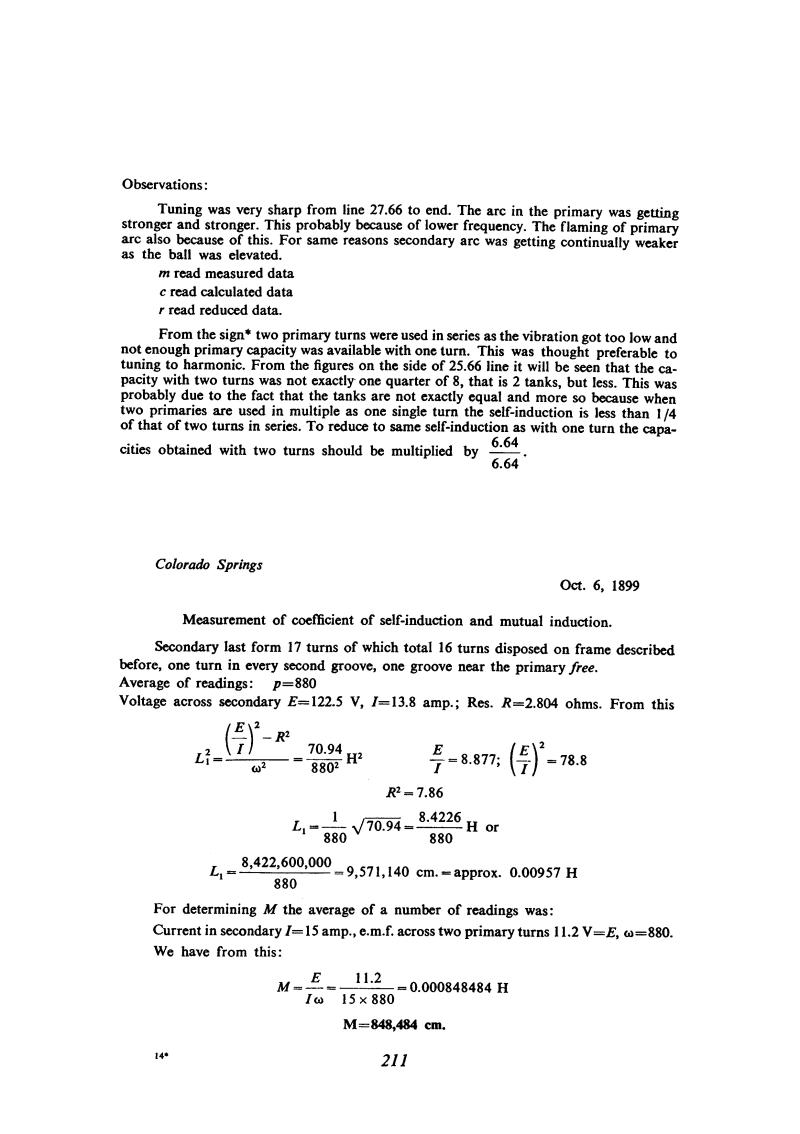
Nikola Tesla Books
Observations:
Tuning was very sharp from line 27.66 to end. The arc in the primary was getting stronger and stronger. This probably because of lower frequency. The flaming of primary arc also because of this. For same reasons secondary arc was getting continually weaker as the ball was elevated.
m read measured data
c read calculated data
r read reduced data.
From the sign* two primary turns were used in series as the vibration got too low and not enough primary capacity was available with one turn. This was thought preferable to tuning to harmonic. From the figures on the side of 25.66 line it will be seen that the capacity with two turns was not exactly one quarter of 8, that is 2 tanks, but less. This was probably due to the fact that the tanks are not exactly equal and more so because when two primaries are used in multiple as one single turn the self-induction is less than 1/4 of that of two turns in series. To reduce to same self-induction as with one turn the capacities obtained with two turns should be multiplied by $! {6.64 \over 6.64} $!.
Colorado Springs
Oct. 6, 1899
Measurement of coefficient of self-induction and mutual induction.
Secondary last form 17 turns of which total 16 turns disposed on frame described before, one turn in every second groove, one groove near the primary free.
Average of readings: p = 880
Voltage across secondary E = 122.5 V, I = 13.8 amp.; Res. R = 2.804 ohms. From this
$! {L_{1}^{2} = {{{\left({E \over I}\right)^{2}} - R^{2}} \over Ï^{2}} = {{70.94 \over 880^{2}} H^{2}}} $!$! {{E \over I} = 8.877} $!; $! {{\left({E \over I}\right)^{2}} = 78.8} $!
R2 = 7.86
$! {L_{1} = {{1 \over 880} \sqrt{70.94}} = {8.4226 \over 880}H} $! or
$! {L_{1} = {8,422,600,000 \over 880} =} $! 9,571,140 cm. = approx. 0.00957 H
For determining M the average of a number of readings was:
Current in secondary I = 15 amp., e.m.f. across two primary turns 11.2 V = E, Ï = 880.
We have from this:
$! {M = {E \over I Ï} = {11.2 \over {15 \times 880}} =} $! 0.000848484 H
M = 848,484 cm.
14*
211
Tesla: âApparatus for transmission of electrical energyâ, U.S. Patent 649 621, May 15, 1900, Appl. Sept. 2, 1897, P-293.
October 5
Tesla checks the secondary coil adjustment. The procedure is already standard. He adjusts the capacitance and inductance in the primary (with coil of variable inductance connected in series) until he achieves the maximum sparks at the secondary terminals. Operating frequency is approximately calculated on the basis of total inductance and capacitance in the primary. The influence of the secondary adjustment to oscillation is checked by a sphere addition of 38.1 cm in diameter and because that has very little influence he draws the conclusion that the distributed secondary capacitance is large.
The same day he continues the notes by writing about the sources of possible errors when determining the variances of globe capacitance with height variance. He give the precise interpolation form according to which method applied on Oct. 4, the desired capacitances variances can be found.
Starting from some height, he has to change the primary coil (by reconnecting the turns in series a connection) due to the small maximum capacitance value in the primary.
October 6-8
From the measured inductance of the new secondary and mutual inductance of the primary and secondary, and the primary inductance measured earlier (see September 25th), it follows that the coupling coefficient was 0.58, i.e. tight coupling*. An oscillator with this much coupling will probably produce three pronounced components, even with very rapid interruption of the spark in the primary; this is indicated by the results Tesla obtained with spark oscillators with looser coupling (see the commentary on 26 September).
As before, Tesla determined the wavelength of the oscillator from the period of the primary circuit (see, e.g., June 20th). He compares one quarter wavelength with the total length of wire in the secondary, special coil and extra coil (when no other coils were used, he considered that the length of the secondary windings should be one quarter wavelength).
October 6
He measures the new secondary inductance and the mutual inductance in the primary and secondary. On the basis of these results and previously measured primary inductance (please see Sept. 25), we find that the link coefficient is 0.58. This indicates a very strong link*. The oscillator spectrum with such a link of the secondary will probably have free emphasized components, even with very fast spark interruptions in the primary. He arrived at this conclusion on the basis of the results achieved in studies of arcing oscillator operation at smaller link coefficient (please see comments Sept. 26).
* The link is reduced when regulating coil is connected in series with primary circuit. It is shown that new link coefficient k1 = k $! {\sqrt{L_{p}/\left({L_{p} + L_{rc}}\right)}} $! < k. Here Lp is the primary inductance, and Lrc is inductance in the regulatory coil of the primary circuit.

